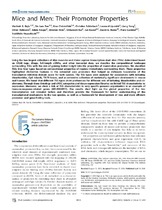| dc.contributor.author | Bajic, Vladimir B. | |
| dc.contributor.author | Tan, Sin lam | |
| dc.contributor.author | Christoffels, Alan | |
| dc.contributor.author | Schonbach, Christian | |
| dc.contributor.author | Lipovich, Leonard | |
| dc.contributor.author | Yang, Liang | |
| dc.contributor.author | Hofmann, Oliver | |
| dc.contributor.author | Kruger, Adele | |
| dc.contributor.author | Hide, Winston | |
| dc.contributor.author | Kai, Chikatoshi | |
| dc.contributor.author | Kawai, Jun | |
| dc.contributor.author | Hume, David, A. | |
| dc.contributor.author | Carninci, Piero | |
| dc.contributor.author | Hayashizaki, Yoshihide | |
| dc.date.accessioned | 2015-09-08T13:42:13Z | |
| dc.date.available | 2015-09-08T13:42:13Z | |
| dc.date.issued | 2006 | |
| dc.identifier.citation | Bajic, V.B. et al. (2006). Mice and men: Their promoter properties. PLoS Genetics 2(4): e54 | en_US |
| dc.identifier.issn | 1553-7404 | |
| dc.identifier.uri | http://hdl.handle.net/10566/1588 | |
| dc.description.abstract | Using the two largest collections of Mus musculus and Homo sapiens transcription start sites (TSSs) determined based on CAGE tags, ditags, full-length cDNAs, and other transcript data, we describe the compositional landscape surrounding TSSs with the aim of gaining better insight into the properties of mammalian promoters. We classified TSSs into four types based on compositional properties of regions immediately surrounding them. These properties highlighted distinctive features in the extended core promoters that helped us delineate boundaries of the transcription initiation domain space for both species. The TSS types were analyzed for associations with initiating dinucleotides, CpG islands, TATA boxes, and an extensive collection of statistically significant cis-elements in mouse and human. We found that different TSS types show preferences for different sets of initiating dinucleotides and ciselements. Through Gene Ontology and eVOC categories and tissue expression libraries we linked TSS characteristics to expression. Moreover, we show a link of TSS characteristics to very specific genomic organization in an example of immune-response-related genes (GO:0006955). Our results shed light on the global properties of the two transcriptomes not revealed before and therefore provide the framework for better understanding of the transcriptional mechanisms in the two species, as well as a framework for development of new and more efficient promoter- and gene-finding tools. | en_US |
| dc.description.sponsorship | RIKEN Genome Exploration Research Project grant
Grant of the genome network project
grant for the strategic program for R&D of RIKEN | en_US |
| dc.language.iso | en | en_US |
| dc.publisher | PLoS Genetics | en_US |
| dc.rights | Open Access copyright Bajic et al. | |
| dc.source.uri | dx.doi.org/10.1371/journal.pgen.0020054 | |
| dc.subject | Mus musculus | en_US |
| dc.subject | Homo sapiens | en_US |
| dc.subject | Promoter properties | en_US |
| dc.subject | Gene-finding tools | en_US |
| dc.subject | Gene ontology | en_US |
| dc.subject | Drosophila melanogaster | en_US |
| dc.subject | Fugu rubripes | en_US |
| dc.subject | DNA | en_US |
| dc.title | Mice and men: Their promoter properties | en_US |
| dc.type | Article | en_US |
| dc.privacy.showsubmitter | false | |
| dc.status.ispeerreviewed | true | |
| dc.description.accreditation | Web of Science | en_US |

